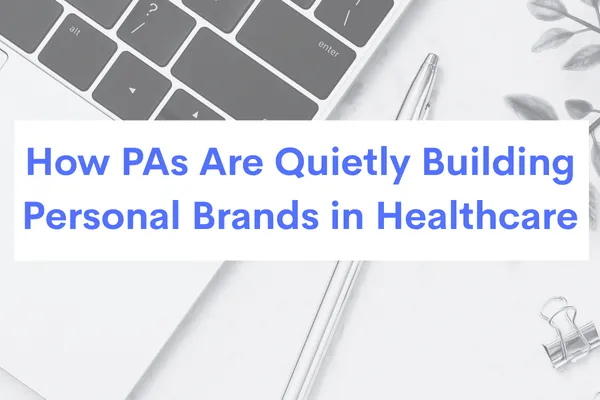
Building Personal Brands in Healthcare
How PAs Are Quietly Building Personal Brands in Healthcare
Physician Assistants are often underestimated in the digital space, but not because they lack experience or insight. It’s because most PAs haven’t been taught to build visibility around what they do best. That’s changing.
Across healthcare, PAs are stepping into new territory, not by chasing followers, but by building presence. They're launching coaching programs, writing newsletters, hosting podcasts, advising startups, and showing up as experts in their own right.
This shift is powered by one thing: a clear personal brand. You don’t need a logo. You need a voice and a strategy.
What Is a Personal Brand (Really)?
Your personal brand is the way people understand your value, before you’re in the room.
It’s not about being known by everyone. It’s about being known by the right people: collaborators, investors, patients, startup teams, hiring managers, or peers looking for exactly what you offer.
A title says what you do. A brand shows what you’re building, what you care about, and how you think. And in healthcare, where trust, credibility, and specialization matter, it’s how you differentiate yourself.
Why It’s Becoming Essential for PAs
Whether you're:
Growing a cash-pay practice
Pivoting into non-clinical roles
Launching a coaching offer
Building a newsletter or podcast
Consulting with a startup
...people need to understand what you bring to the table. And they won’t see it if your entire professional presence stops at “PA-C.”
In short: personal branding is no longer optional for PAs who want to be visible, valuable, and taken seriously outside the EMR.
Where and How PAs Are Building Personal Brands
1. LinkedIn
Still the highest-leverage platform for visibility, networking, and credibility. PAs are using it to:
Talk about trends in their specialty
Share lessons from clinical entrepreneurship
Comment on healthcare innovation and tech
Connect with founders, marketers, and operators
Even one post a month—done with clarity—can put you on someone’s radar.
2. Newsletters + Substack
Email is still powerful. Some PAs are writing short weekly newsletters on:
Women's health misinformation
Running a cash-based clinic
Navigating burnout and identity in medicine
Clinical trends, side hustles, and emerging tools
A niche, thoughtful Substack gives people a reason to follow your work—and brings opportunities you’ll never find on job boards.
3. Podcasts (Hosting or Guesting)
PAs are increasingly starting or guesting on healthcare podcasts—not to “be influencers,” but to lead conversations around:
Innovation in care delivery
Business models for clinicians
Leadership, burnout, and mental health
The lived experience of practicing medicine
Even a few strategic guest spots can change how you're seen.
4. Coaching + Education
Many experienced PAs are now coaching others:
Early-career PAs looking to negotiate better roles
Entrepreneurs trying to launch wellness clinics
Clinicians transitioning to consulting or public speaking
Others are creating mini-courses, mentorship offers, and strategy sessions. These offerings are easier to grow when your brand clearly communicates what you help with—and who you help.
5. Instagram, TikTok, and YouTube (Used Intentionally)
Forget going viral. The best PAs are using social media to:
Break down complex health topics in accessible ways
Share their own entrepreneurial journey
Teach mindset and leadership
Drive traffic to their site, newsletter, or course
It’s not about being trendy—it’s about showing up where your audience already is.
Strong PA Personal Brands: Real Examples
Forget the generic “I’m a dermatology PA.” These are examples of actual positioning that builds opportunity:
A surgical PA posting breakdowns of real OR workflow inefficiencies, gaining advisory roles for EHR startups.
A women’s health PA writing about underdiagnosed conditions in midlife patients—now teaching other PAs how to build menopause-focused practices.
A former urgent care PA who pivoted into coaching new grads on negotiation, onboarding, and burnout—built entirely from her LinkedIn content.
A mobile wound care PA consulting on SNF tech implementation and being paid to train new care teams in other states.
A functional medicine PA who grew her brand through a podcast and now co-hosts an education series with other health pros.
They’re all still PAs. But their name now means more than their title.
How to Build Your Own Brand (Without Overthinking It)
1. Clarify what you're about
What’s your lens? What do you want people to associate you with? You don’t need to pick a niche forever—but start with one focus area where you can lead.
2. Build your landing zone
Update your LinkedIn profile. Create a one-pager. Start a basic website or Linktree. Make it easy to contact you and see your work.
3. Choose one content channel to start
Write a post. Publish a newsletter. Launch a 5-episode podcast series. You don’t need to do everything—just be consistent in one place.
4. Be useful, not promotional
Focus on sharing ideas, frameworks, breakdowns, or lessons learned. Position yourself as someone worth paying attention to—not just someone to follow.
5. Let your name circulate
Show up in comments. Join conversations. Share your work when it’s relevant. Branding isn’t just content—it’s contribution.
Final Word
If you want to stay in your lane, there’s no pressure. But if you want to be known for more than a title, now is the time to build that.
PAs are no longer limited to clinic walls. They’re advising product teams. Leading movements. Educating at scale. Starting companies. Coaching peers. Being hired for what they know—not just what they bill.
And the ones who are getting those calls? They’re not the most famous. They’re the most clear.
